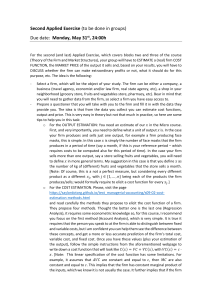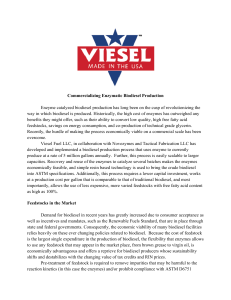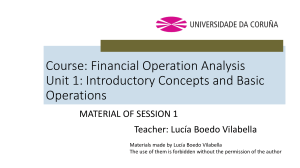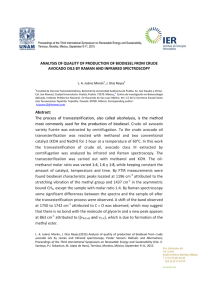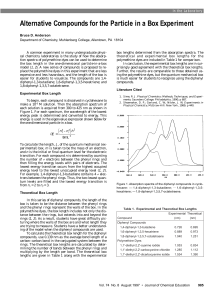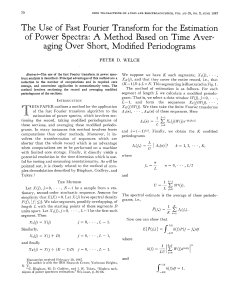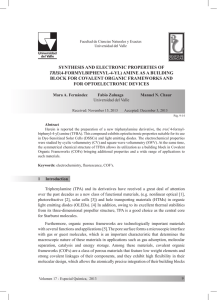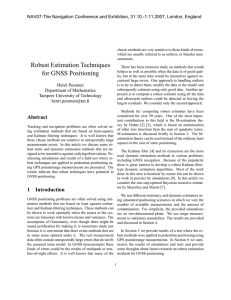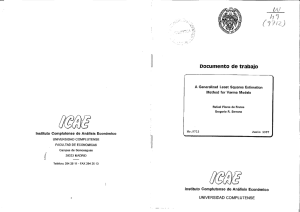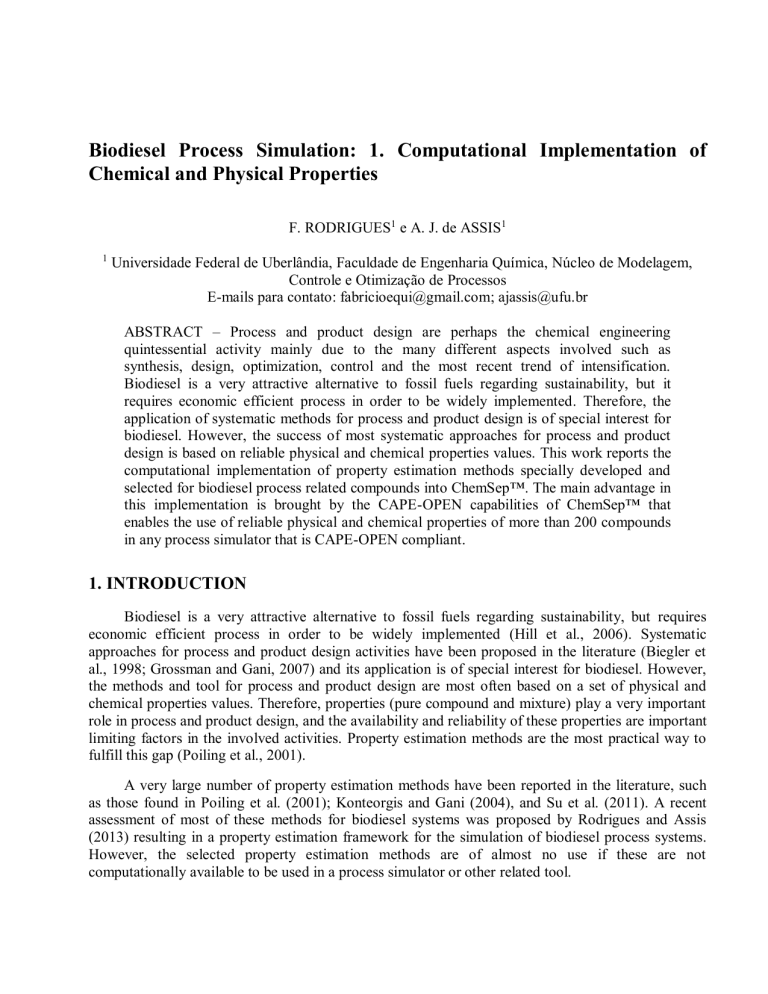
Biodiesel Process Simulation: 1. Computational Implementation of Chemical and Physical Properties F. RODRIGUES1 e A. J. de ASSIS1 1 Universidade Federal de Uberlândia, Faculdade de Engenharia Química, Núcleo de Modelagem, Controle e Otimização de Processos E-mails para contato: fabricioequi@gmail.com; ajassis@ufu.br ABSTRACT – Process and product design are perhaps the chemical engineering quintessential activity mainly due to the many different aspects involved such as synthesis, design, optimization, control and the most recent trend of intensification. Biodiesel is a very attractive alternative to fossil fuels regarding sustainability, but it requires economic efficient process in order to be widely implemented. Therefore, the application of systematic methods for process and product design is of special interest for biodiesel. However, the success of most systematic approaches for process and product design is based on reliable physical and chemical properties values. This work reports the computational implementation of property estimation methods specially developed and selected for biodiesel process related compounds into ChemSep™. The main advantage in this implementation is brought by the CAPE-OPEN capabilities of ChemSep™ that enables the use of reliable physical and chemical properties of more than 200 compounds in any process simulator that is CAPE-OPEN compliant. 1. INTRODUCTION Biodiesel is a very attractive alternative to fossil fuels regarding sustainability, but requires economic efficient process in order to be widely implemented (Hill et al., 2006). Systematic approaches for process and product design activities have been proposed in the literature (Biegler et al., 1998; Grossman and Gani, 2007) and its application is of special interest for biodiesel. However, the methods and tool for process and product design are most often based on a set of physical and chemical properties values. Therefore, properties (pure compound and mixture) play a very important role in process and product design, and the availability and reliability of these properties are important limiting factors in the involved activities. Property estimation methods are the most practical way to fulfill this gap (Poiling et al., 2001). A very large number of property estimation methods have been reported in the literature, such as those found in Poiling et al. (2001); Konteorgis and Gani (2004), and Su et al. (2011). A recent assessment of most of these methods for biodiesel systems was proposed by Rodrigues and Assis (2013) resulting in a property estimation framework for the simulation of biodiesel process systems. However, the selected property estimation methods are of almost no use if these are not computationally available to be used in a process simulator or other related tool. Modern computational Chemical Engineering tools (software) are much influenced by the CAPE-OPEN interoperability standard, which has proposed a component (piece of software) architecture and clear interface standards. The authors developed a software presented in a previous work (Rodrigues and Assis, 2013), called BioPES (BIOdiesel Property Estimation System), which was able to calculate most of the important physical properties of 232 compounds involved in general biodiesel process and, initially, the idea was to make BioPES CAPE-OPEN compliant. Nevertheless, the simulator used in our research group is COCO (CAPE-OPEN to CAPE-OPEN), whose thermophysical property package is that of ChemSep™ (van Baten, 2010). So, we decided to integrate BioPES to ChemSep™, resulting in an easiest work path. ChemSep™ already has an efficient software architecture that enables the addition of its own compounds database and property package with the compounds involved in biodiesel and the property estimation methods selected by Rodrigues and Assis (2013). 2. COMPUTATIONAL IMPLEMENTATION1 The framework for property estimation proposed by Rodrigues and Assis (2013) has the structure shown in Figure 1 and provides appropriate models for the estimation of several properties for 232 compounds. Define Compound and Conditions (T, P, x) Step 3: Estimate Primary Properties Tc, Pc, Vc, Gf, Hf, Tb, Tm Constantinou and Gani (1996) Step 2: Define Compound Type Step 4: Estimate Secondary Properties Fatty Acid ρ Halvordensen et al. (1993) Acylglyceride Pvap Ceriani et al. (2013) Cp Ceriani et al. (2009) Vegetable Oil µ Ceriani et al. (2011) Fatty Acid Alkyl Ester ΔHvap Ceriani et al. (2013) Database: Model parameters and other required data Figure 1 – State-of-art property estimation methods for biodiesel process systems (Rodrigues and Assis, 2013). Before any discussions, the authors want to clarify that here the words compound and component are used with very different meanings. The word compound is used for chemical species, whereas component is a piece of software usually connected to other components through middleware (usually COM or CORBA). 1 To increment the framework shown in Figure 1 into ChemSep™ was only possible due to some of its features. 2.1. ChemSep™ Important Features ChemSep™ has a component that manages the information regarding pure compounds, called PCDmanager, in which the user can perform several tasks such as access pure compound properties, add a new compound, insert and update correlation parameters for temperature dependent properties. Among these tasks, some are of critical importance for the accomplishment of this work: export compound to file and import compound from file. ChemSep-Lite™ has 432 compounds in PCDmanager and by choosing one of these compounds and exporting it to a file one encounters a simple text file that can be divided in: 1. Compound Identifiers (Name, Formula, CAS, Smiles and Family) 2. Pure Compound Primary Properties (Critical Properties, Molecular Weight, Boiling Point and Melting Point, to name a few). 3. Parameters for 17 Pure Compound Temperature Dependent Properties (Solid Density, Liquid Density, Vapor Pressure and Heat of Vaporization, to name a few). 4. Additional Pure Compound Parameters for Calculation of Mixture Properties and Molecular Properties (UNIQUAC r and q, Chao-Seader acentric factor, Chao-Seader solubility parameter) 5. Group Contribution Data (UNIFAC, UNIFAC-LLE, ASOG and Modified UNIFAC, to name a few). Therefore, to add compounds to ChemSep™ systematically, all that is required is to create such text file holding all the required information and then add the compounds through PCDmanager using this text file. The process to increment ChemSep™ with the property estimation framework is also explained by Figure 2. BioPES Property Estimation Framework (Rodrigues and Assis, 2013) Create Compound Text File (ChemSep can export such files) Import (ChemSep PCDmanager pure compound manager) Figure 2 – Process to implement the property estimation framework on ChemSep™. An additional difficulty to the process explained in Figure 2 is that the temperature dependent correlations are based on a set of 35 defined model forms2. Unfortunately, no estimations methods in the framework have the defined model forms, for instance some of the methods are based on group contribution plus a correction term. To overcome this issue a parameter estimation procedure was developed on MS Excel. The model forms are the same used in the DIPPR databank and a complete list can be found at http://www.chemsep.com/downloads/docs/ChemSepTutorial_PCDManager.pdf 2 2.1. Parameter Estimation Procedure Even though the estimation methods/models were not directly constructed in any of the defined equation forms shown in Appendix 1, all of them do follow at least one of the 35 defined model forms as shown in the Figure 3 and 4 for the liquid density and heat of vaporization, respectively. Figure 3 – Pamitoleic acid liquid density values generated using Halvordensen et al. (1993) and a nonlinear regression using the model form number 105 ( 𝑦 = 𝐴/𝐵^[1 + (1 − 𝑇/𝐶)^𝐷] ). Figure 4 – Pamitoleic acid heat of vaporization values generated using Ceriani et al. (2013) and a nonlinear regression using the model form number 106 – (𝑦 = 𝐴(1 − 𝑇𝑟)^[𝐵 + 𝐶. 𝑇𝑟 + 𝐷. 𝑇𝑟 2 + 𝐸. 𝑇𝑟 3 ] ). Therefore, all that is necessary is to obtain the parameters for 6 temperature dependent properties for all the 232 compounds that means to perform at least 1362 nonlinear regressions. All the necessary data can be generated on BioPES and the nonlinear regressions are easily done on Excel through the development and application of an appropriate macro that systematically calls Excel Solver. The process to obtain the property estimation model parameters in a model form compatible with ChemSep™ is summarized in Figure 5 with a few more details. BioPES Property Estimation Framework (Rodrigues and Assis, 2013) 1 Data Points (At least 35 data points generated for each temperature dependent model for each compound) 2 4 MS Excel Parameters (Framework property estimation models in appropriate form) 3 Macro to Perform 1362 Nonlinear Regressions Systematically Figure 5 – Process to obtain the property estimation model parameters in an model form compatible with ChemSep™ in four steps. The nonlinear regression was only accepted when the coefficient of correlation was higher than 0.99 resulting in 227 compounds with all the correlation parameters determined. An example of the results for Trimyristin is given in Table 1. 2.2. Compound Text Files Generation and Compounds Addition to ChemSep™ After obtaining the property estimation model parameters in an model form compatible with ChemSep™ all the requirements to accomplish the task defined in Figure 2 (create the compound text files and import them on PCDmanager) are met. The compound text file generation was done through BioPES using the .NET Framework and, using these files, the compounds were finally add to ChemSep™ using the “Import from File” feature. At this point, the only step to be accomplished was to save the work. The file generated contains 660 compounds (432 originally included and 228 add in this work) with several reliable, constant and temperature dependent, physical property values ready to be used in a distillation column simulation using ChemSep™ or an entire plant simulation using COCO simulator or any other simulator that is CAPE-OPEN compliant such as Aspen Plus™. The final file containing all the information can be obtained via email contact to the authors. Table 1 – Nonlinear Estimation Results for Trimyristin. Equation Number Liquid Density 105 Vapor Pressure 101 Heat of Vaporization 106 Heat Capacity 2 Liquid Viscosity 101 Surface Tension 101 Equation Form 𝑦 = 𝐴/𝐵^[1 + (1 − 𝑥/𝐶)^𝐷 𝐵 𝑦 = 𝑒 𝐴+ 𝑇 +𝐶.ln(𝑇)+𝐷.𝑇 𝐸 𝑦 = 𝐴(1 − 𝑇𝑟)^[𝐵 + 𝐶. 𝑇𝑟 + 𝐷. 𝑇𝑟 2 + 𝐸. 𝑇𝑟 3 ] 𝑦 = 𝐴 + 𝐵. 𝑇 𝐴 𝐵 0.289 0.4443 194.2 𝐶 808.40 𝐷 0.5848 𝐸 -29241 22.028 0.0002 -0.375 4.27.107 -9.468 25.448 -25.98 9.857 1.01.106 1530.5 - - - - 𝐵 𝐸 -32.186 4813.2 4.756 0.0005 -2 𝐵 𝐸 0.0281 -3.01.10-5 - - - 𝑦 = 𝑒 𝐴+ 𝑇 +𝐶.ln(𝑇)+𝐷.𝑇 𝑦 = 𝑒 𝐴+ 𝑇 +𝐶.ln(𝑇)+𝐷.𝑇 3. RESULTS The implementation was successfully loaded on COCO simulator as shown in Figure 6 and, as an initial validation, the biodiesel production process from waste cooking oil (triolein) proposed by Zang et al. (2003) simulated on HYSYS™ was reproduced as represented in Figure 7. Figure 6 – COCO flowsheet configuration GUI showing some of the Compounds added in this work. Figure 7 – Simulation of the biodiesel production process from Canola oil (Triolein) proposed by Zhang et al. (2003) using COCO simulator and the framework implemented in this work. The simulation results were exact the same as those reported by Zhang et al. (2003). It should be mentioned that triolein (the compound representing the waste cooking oil) is usually the only triglyceride found in most of the commercial simulators and the advantage in using the implementation developed here is that other compounds present in the waste cooking oil can be included in the analysis, resulting in a more detailed description of the system. Furthermore, any other biodiesel production systems composed by the 228 compounds included in the framework can be approached using the reliable property estimation methods. 4. CONCLUSIONS The successful computational implementation described in this work shows the capabilities of integrating several different methods and tools towards a common objective. One may realize that the computational implementation developed here has a considerable resemblance to the CAPE-OPEN standard, even though the former is not as elegant as the later, each of the tools used are specialized in a certain task and the communication between the different tools were carefully controlled by the author’s strategy. The contribution of this work applied for biodiesel process synthesis and design is presented in a subsequent article (Rodrigues and Assis, submitted for publication). 5. NOMENCLATURE 𝐴, 𝐵, 𝐶, 𝐷 and 𝐸 – Correlation Parameters [-]. Cp – Heat Capacity [J/kmol.K]. Pc – Critical Pressure [Pa]. Pvap – Vapor Pressure [Pa]. Vc – Critical Volume [m3/kmol]. 𝑇 – Temperature [K]. Tb – Normal Boiling Point [K]. Tc – Critical Temperature [K]. Tm – Melting Point [K]. 𝑇𝑟 – Reduced Temperature [-]. 𝑦 – Property Calculated by the Correlation [-]. 𝜇 – Liquid Viscosity [kmol/m3]. ∆𝐻𝑓 – Standard Heat of Formation [J/kmol]. ∆𝐻𝑣𝑎𝑝 –Heat of Vaporization [J/kmol]. ∆𝐺𝑓 – Standard Gibbs Energy of Formation [J/kmol]. 𝜌 – Liquid Density [kmol/m3]. 6. REFERENCES BIEGLER, L. T.; GROSSMANN, I. E.; WESTERBERG, A. W. Systematic Methods of Chemical Process Design. New Jersey: Prentice Hall, 1998. BOILING, B. E.; PRAUSNITZ, J. M.; O'CONNEL, J. P. The Estimation of Physical Properties. In: BOILING, B. E.; PRAUSNITZ, J. M.; O'CONNEL, J. P. The Properties of Gases and Liquids. 5th. ed. New York: McGraw-Hill, 2001. Cap. 1, p. 1-3. CERIANI, R.; GANI, R.; MEIRELLES, A. J. A. Prediction of heat capacities and heats of vaporization of organic liquids by group contribution methods. Fluid Phase Equilibria, 283, 2009. 49-55. CERIANI, R.; GONCALVES, C. B.; COUTINHO, J. A. P. Prediction of Viscosities of Fatty Compounds and Biodiesel by Group Contribution. Energy & Fuels, 25, 2011. 3712-3717. GANI, R.; GROSSMANN, I. E. Process Systems Engineering and CAPE – What is Next? 17th European Symposium on Computer Aided Process Engineering – ESCAPE17., 2007. HALVORDENSEN, J. D.; MAMMEL, W. C.; CLEMENTS, L. D. Density Estimation for Fatty Acids and Vegetable Oils Based on Their Fatty Acid Composition. Journal of the Americal Oil Chemists' Society, v. 70, n. 9, 1993. HILL, J.; NELSON, E.; TILMAN, D.; POLASKY, S.; TIFFANY, D. Environmental, economic, and energetic costs and benefits of biodiesel and ethanol biofuels. Proceedings of the National Academy of Sciences of the United States of America, v. 103, n. 30, p. 11206-11210, 2006. KONTEORGIS, G. M.; GANI, R. In: KONTEORGIS, G. M.; Part II: Models for Properties. GANI, R. In: Computer Aided Property Estimation for Process and Product Design. Netherlands: Elsevier B. V., 2004. p. 45-276. RODRIGUES, F.; ASSIS, A. J. Property Estimation Methods for Biodiesel Process. Congresso Brasileiro de Termodinâmica. Uberlândia, 2013. SU, Y. C.; LIU, Y. A.; TOVAR, C. A.; GANI, R. Selection of Prediction Methods for Thermophysical Properties for Process Modelling and Product Design of Biodiesel Manufacturing. Industrial & Engineering Design, v. 50, p. 6809-6836, 2011. VAN BATEN, J.; KOOJIMAN, H.; TAYLOR, R. Flowsheeting for Free with COCO., CACHE News. 2010. ZHANG, Y.; DUBÉ, M. A.; MCLEAN, D. D.; KATES, M. Biodiesel production from waste cooking oil: 1. Process Design and Technological Assessment. Bioresource Technology, v. 89, p. 1-16, 2003. 7. ACKNOWLEDGEMENT The authors would like to thank the Brazilian National Council for Scientific and Technological Development for scholarship and the Research Foundation of the State of Minas Gerais (FAPEMIG) for funding this work. Powered by TCPDF (www.tcpdf.org)
